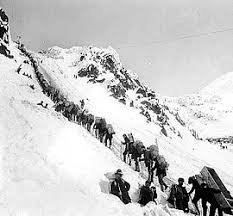A primer for the Yukon arts scene
To understand the importance of the cultural upswing amongst Indigenous communities, it is important to review the timeline of their journey to this day.
In the 17th and 18th centuries, contact with non-Indigenous people was sporadic. Impacts on Indigenous communities were swift and incisive: when arriving Europeans established communities, many Indigenous Peoples abandoned their traditional land-based lifestyles in favour of a Euro-centric economic agenda.
From the beaver fur trade up to the mid-nineteenth century, to the Klondike Gold Rush at the end of the 19th century, to the construction of the Alaska Highway, short-term commercial gain dug into Yukon’s natural resources, undisturbed since around 11,000 years ago when the Indigenous population’s ancestors are considered to have arrived in the area. The attention of Canadian politicians came and went with economic demand, and soon enough First Nations were regarded as dispensable commodities
 In the immediate wake of the gold rush, the population of Yukon was 27,000 in 1900, of which there were 3,000 Indigenous Peoples; by 1912, that had petered out to 6,000 total inhabitants. The highly-mobile settler population had left the premises once the mining economy had been depleted, leaving an unstable landscape for the Indigenous population who had to fumble with getting back to the land.
In the immediate wake of the gold rush, the population of Yukon was 27,000 in 1900, of which there were 3,000 Indigenous Peoples; by 1912, that had petered out to 6,000 total inhabitants. The highly-mobile settler population had left the premises once the mining economy had been depleted, leaving an unstable landscape for the Indigenous population who had to fumble with getting back to the land.
Previously remote regions were suddenly teeming with prospectors, miners, loggers, construction workers (for roads and hydroelectric projects), and others in step with the vast Canadian resource boom. Authors Poelzer and Coates write, “[with the postwar boom,] Aboriginal communities found themselves caught in the maelstrom of an expansionist and culturally insensitive new economic order.”
When First Nations workers in Yukon weren’t being engaged in settler-led projects, their communities were being forcibly “culturized” into a more European worldview. The main components of evangelization, education and sedentary agriculture were enforced by the federal Department of Indian Affairs with the goal of “elimination of Indianness.” From the 1830s onwards, entire communities were forcibly relocated onto reserves while children were sent to residential schools from the late 19th century onwards.
Indigenous communities also fell victim to foreign diseases introduced from Europe, killing 50 to 90 per cent of communities. In Dawson City, diseases like measles, chicken pox, scarlet fever, diphtheria, and tuberculosis decimated the town and further disrupted the Indigenous Peoples’ activities.
At the height of the Klondike Gold Rush between 1896 and 1898, Dawson City’s population grew from 500 to 30,000. By the spring of 1897, miners had completely overrun the Tr’ondëk Hwëch’in First Nation’s traditional fishing grounds, forcing them to relocate down the Yukon River.
And yet, the federal government was only preoccupied with staking the area ahead of the American prospectors. In the early 1890s, missionaries had complained to Ottawa that “if there really was gold in those godforsaken subarctic regions, it was Canadian, not American, and Canada should benefit.” As historian Charlotte Gray notes, “it was evident that southern racism meant the two [Indigenous and non-Indigenous] communities could not integrate.”
The assumption among governmental bodies was that the Indigenous Peoples would all but disappear from the Canadian landscape. By the 1930s, however, the trend was reversing. With better political organization such as what centred around the precursor to modern land claims, a new recognition and willingness to harness the economic benefits of the lands under their control, Indigenous Peoples began to re-emerge from the shadows.
Residential Schools
The intention of residential schools, or “boarding schools,” was to instill marketable skills in students so they could integrate into the paid workforce. “The government believed that by keeping First Nations away from non-Aboriginal Canadians, it could slowly raise their wards to the standards of the rest of the country.”
 But the Indigenous population was resilient. By the late 1940s, they had adopted technology that had been introduced: high-powered rifles, snow machines and outboard motors were in use by their communities. In history professor Paul Robert Magocsi’s words, they adopted a positive lifestyle that combined deep cultural roots with a realization of the benefits of economic activity in their communities.
But the Indigenous population was resilient. By the late 1940s, they had adopted technology that had been introduced: high-powered rifles, snow machines and outboard motors were in use by their communities. In history professor Paul Robert Magocsi’s words, they adopted a positive lifestyle that combined deep cultural roots with a realization of the benefits of economic activity in their communities.
Historically, Indigenous Peoples were taken seriously when they had what the newcomers wanted – furs, land, minerals. Today, the by-products of exploitation continue to linger in their communities: incarceration, family breakdown, substance abuse and disputes over resource management on their lands – sometimes turning violent, as in the case of the Trans Mountain Pipeline, most notably.